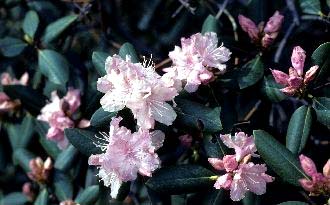| |
HERBS FOR THE KITCHEN
|
| |
Wild herbs for use in salads, sauces, and soups add zest to greenhouse vegetables. In spring they are especially tender and grow plentifully everywhere.
Not so long ago, before there were neighborhood supermarkets everywhere to provide fresh vegetables from all over the world, it was common-place for people to supplement their menus with fresh, handpicked wild herbs. There is no reason not to do the same today, because the few skills and experience needed are easily learned.
Tried and True
On just about any walk through the woods and fields, at any time of year, you are bound to find wild herbs that can be used in cooking. Many of them, such as goutweed, for example, have long and venerable traditions of use. Others, however, have only recently been "discovered." Take dandelion. It was long regarded as a weed, and sometimes touted as the "secret" ingredient in hearty spring salads; now there are many dandelion cultivars available.
Many wild herbs contain essential oils and bitter substances that both stimulate the appetite and exert therapeutic effects on the human body. The boundaries between medicinal herbs, seasoning herbs, and wild plants that can be used as vegetables are not hard and fast. Plantain can be consumed fresh like lettuce, for example, and the dried form is an ingredient in many herbal teas. Violets make handsome garnishes for salads and soups.
Guidelines for Collecting Herbs
1. Do not pick and consume any plants that you cannot identify. Many wild plants are poisonous.
2. Pick only healthy plants; don't pick any that are damaged or have been attacked by parasites. Use a basket or paper bags, not plastic, to carry them in; baskets and paper will let in air and keep them dry.
3. Fallow farm lands and the banks of water reservoirs are excellent places to collect herbs. No fertilizing or spraying with pesticides is permitted in such areas. Avoid the periphery of heavily cultivated fields, the sides of roads, and the outskirts of towns.
4. The best time to pick is late afternoon, when last night's dew has dried off the plants and tonight's has not yet begun to form. Keep track of and organize your pickings as you collect the plants; this will save having to sort them out later. Most herbs are especially mild and flavorful just before they flower. Many flowers, however, are also edible.
Wild Herbs in the Garden
Many wild herbs can be cultivated in the home garden without any problems at all. Some seed nurseries specialize in wild herbs and offer extensive varieties for sale. The garden location and the growing conditions must be right for the herb, of course, if you are to be able to harvest tasty leaves. And don't forget that herbs should not be fertilized or sprayed with pesticides.
For Tasty Dishes
Many wild plants can be consumed either raw or cooked. The major species of wild herbs useful for culinary purposes are provided in the chart that follows. For salads, wash the herbs, dice them, and prepare them in a marinade of vinegar, oil, and onions. Yogurt or sour cream will soften the taste of very bitter herbs. Wild herbs may be steamed briefly and then saut�ed in butter.
SEASONING HERBS: Bear's garlic (Allium ursinum), mint (Mentha species), wild chervil (Anthriscus sylvestris), wild oregano (Monardo didyma), and wild thyme (Thymus serpyllum) are excellent herbs for seasoning salads, soups, and sauces. The rootstock of wild sunflower (Inula Helenium) can be used to flavor desserts.
|
Selection of the Most Important Wild
Culinary Herbs |
|
Species |
Harvesting Period |
Usable Parts |
Uses |
|
Winter cress (Barbarea
vulgaris) |
Spring |
Leaves |
Salads, vegetable |
|
Comfrey (Symphytum
officinale) |
Spring |
Sprigs, leaves |
Vegetable |
|
Pimpinella (Pimpinella
major) |
Spring |
Leaves |
Salads, vegetable |
|
Nettle (Urtica
dioica) |
Spring |
Leaves |
Salads, herbal tea,
vegetable |
|
Watercress (Nasturtium
officinale) |
Spring and Fall |
Leaves, flowers |
Salads, sauces |
|
English daisy (Bellis
perennis) |
Spring to Fall |
Leaves, flowers |
Salads, soups, sauces |
|
Goutweed (Aegopodium
podagrana) |
Spring |
Leaves |
Vegetable |
|
Coltsfoot (Tussilago
farfara) |
Spring to Summer |
Leaves |
Salads, herbal, teas,
soups |
|
Dandelion (Taraxacum
officinale) |
Spring |
Leaves |
Salads |
|
Parsnip (Pastinaca
sativa) |
Fall |
Roots |
Vegetable, soups |
|
Garden sorrel (Rumex
acetosa) |
Spring to Fall |
Leaves |
Vegetable, salads, soups,
sauces |
|
Common yarrow (Achillea
millefolium) |
Spring |
Leaves |
Salads, sauces |
|
Celandine (Ranunculus
ficaria) |
Spring |
Leaves before flowering |
Salads, soups, vegetable |
|
Dead nettle (Lamium
species) |
Spring |
Leaves |
Vegetable |
|
Chickweed (Stellaria
media) |
Spring to Fall |
Tender shoots |
Vegetable |
|
Plantain (Plantago
species) |
Spring to Fall |
Leaves |
Salads, soups, herbal teas |
|
Wild chervil (Anthriscus
sylvestris) |
Spring |
Young leaves |
Soups, sauces, salads |
|
Bumet (Poterium
sanguisorba) |
Spring to Fall |
Young leaves |
Soups, salads |
|
Wild carrot (Daucus
carota) |
Late summer to Fall |
Roots |
Soups, vegetable |
|
|
|


